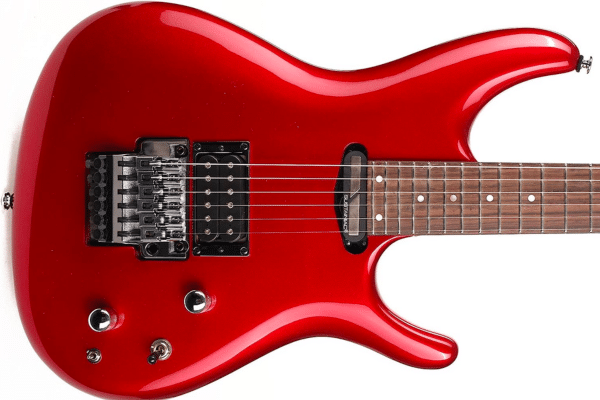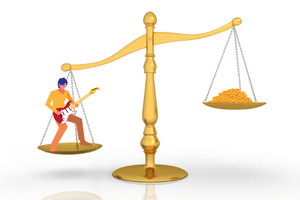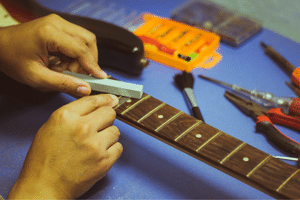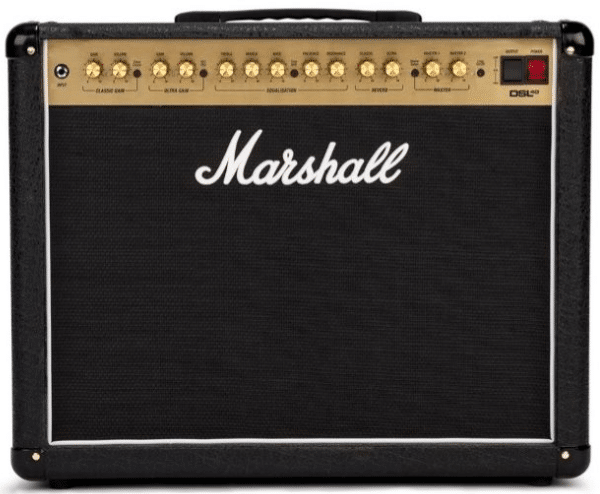Hello, fellow guitar enthusiasts! Today, we’re going to break down exactly how to get more sustain on clean tone without the aid of overdrive or distortion! Have you ever wondered how some guitarists can create beautifully clear and unwavering notes that seem to go on forever? Well, you’re in luck because all you have to do is keep reading!
You can use the table of contents below to take you to the area that interests you. Click on the little box to open it, and then click on the section of the article you want to read, or you can read from start to finish if you want the full tonal experience!
The Short Answer
Installing new strings and cleaning the frets can increase note sustain when playing clean tones. If that doesn’t help, adjust the guitar setup and amp settings or use an effects pedal. Modifications to your guitar include changing the nut, tuners, and tremolo block. Proceed in this order to achieve the best results and save time and money.
Keep On Reading (Below) To Learn More
What Is Sustain?
First things first, what is sustain? In the simplest terms, sustain refers to how long a note can be held or ‘sustained’ after being plucked or strummed before it fades to silence. As electric guitar players, we’re fortunate enough to have a range of techniques and equipment adjustments at our disposal to increase sustain and create that magical, enduring sound.
Like electrics, acoustic guitars have a natural amount of sustain that comes from the strings vibrating the tonewoods of the neck and body, but you can’t really increase the sustain without making adjustments to the guitar or changing the strings.
Getting Maximal Sustain With A Clean Tone

Here is a table that shows you how to adjust the settings on an electric guitar, a boost pedal, a compressor, and a guitar amplifier to get the most sustain while maintaining a clean sound.
These are general guidelines. The exact settings will depend on your specific equipment and personal preferences. Experimenting and finding what works best for you is always a good idea.
| Equipment | Setting | Purpose |
|---|---|---|
| Electric Guitar | Pickup Selector: Select pickup with the highest output or longest string vibration | The bridge pickup often has a higher output with more sustain, but the strings under the neck pickup can vibrate longer. |
| String Action: Medium | Too low might cause fret buzz, too high might make it hard to play. Medium action is a good balance. | |
| Volume Control: As high as possible | Too high a setting can add dirt to the clean signal. | |
| Tone Control: Adjust to taste | This will depend on the specific sound you’re looking for. May be adjusted to give more sustain in the bass, mid, or treble range. | |
| Pick Attack: Affects note duration | The pick material, thickness, angle, and force used all affect sustain and tone. | |
| Boost Pedal | Level: High | Boosts the signal going into the other pedals/amplifier, increasing sustain. |
| Tone: Neutral | To maintain a clean sound, don’t alter the tone too much. | |
| Compressor Pedal | Sustain/Compression: High | Increases sustain by leveling out the volume of the notes played. |
| Level/Volume: Match bypassed signal | To avoid volume jumps when the pedal is engaged. | |
| Attack: Slow | Allows the initial pick attack to come through, keeping the sound more natural. | |
| Guitar Amplifier | Gain: Low to Medium | High gain can lead to distortion. Keep it lower for a clean sound. |
| Volume: Adjust to taste | This will depend on your specific situation. | |
| EQ Settings: Adjust to taste | This will depend on the specific type of sound and sustain you’re looking for. |
Keep On Reading (Below) To Learn More About Each Topic
How Each Part Of Your Rig Creates Sustain
The Guitar
Your guitar has its own natural sustain, even if it’s strummed or picked without being plugged into effects pedals and an amplifier. The sustain originates from the strings vibrating the neck and body of the instrument. All guitars, acoustic and electric, behave this way!
The first thing to do is remove the guitar strings, thoroughly clean the guitar, and then install a new set of strings. Dirty or worn-out strings and gunk buildup on the frets can easily kill sustain!
Making certain adjustments to your guitar, like changing the string gauge, string action, pickup height, and truss rod adjustment can also affect its overall sustain.
Electric guitar pickups can also add varying amounts of sustain, depending on the design. Double-coil pickups usually have more sustain than single-coil designs due to their higher output. The higher output drives the amp harder.
Increasing the pickup height (bringing it closer to the strings) can improve overall sustain. However, bringing the pickup too close to the strings can cause the magnetic string pull to decrease the sustain and create problems with intonation! So, you need to find the pickup’s “sweet spot.”
Some pickups are created to add infinite sustain to the guitar’s output signal. For example, the Joe Satriani Ibanez JS2480 uses the Sustainiac system with a specially designed pickup in the neck position. It has a three-way switch that can give you a harmonic overtone of the note you’re holding, resonate the note you’re playing, or blend the two.

I love the way this guitar pays and sounds! The Sustainic pickup can give your notes infinite sustain when properly used.
Pick Attack
The pick attack – the manner in which you pluck the strings with your pick – can influence the sustain of your guitar’s notes while still maintaining a clean tone. Here’s how:
- Strong, Controlled Pick Attack: A stronger, confident pick attack can make the strings vibrate more, leading to increased sustain. However, it’s crucial to balance the strength of the attack. Striking the string too hard might lead to unwanted distortion or ‘clipping’ of the sound, while too soft of a touch may fail to produce adequate sustain.
- Picking Angle: The angle at which you strike the strings can also impact sustain. By experimenting with different angles, you can find the sweet spot that allows you to get more sustain while still keeping a clean sound.
- Placement of the Pick: Where you pick the strings along the length of the string can also affect sustain. Picking closer to the bridge can yield a brighter tone with potentially more or less sustain, depending on the pickup, while picking near the neck provides a warmer tone.
- Pick Material and Thickness: The material and thickness of your pick can also influence sustain. Thicker picks can generally produce more sustain because they transfer more energy to the strings. However, they might require more control to maintain a clean tone compared to thinner picks.
- Consistency in Picking: Consistency in your picking attack allows you to maintain a steady, uniform sound, which helps prolong sustain while keeping the sound clean. Inconsistent picking can lead to notes dying out prematurely or unwanted tonal variations.
It takes practice, patience, and attention to detail to master the art of pick attack, but the results in terms of sustain and tone cleanliness are well worth the effort.
Effects Pedals
Booster and compressor pedals can increase a guitar’s sustain while keeping the tone clean. Overdriving the amplifier with a dirt pedal, like an overdrive, can easily distort the sound, even on the lower gain settings.
The easiest way to get a clean tone with lots of sustain is by using a compressor pedal. However, overcompressed tones can diminish the attack and rob your notes of dynamics, so it’s a tradeoff.
That’s where using a booster pedal can have more of an advantage than a compressor.
One trick I use is to run my guitar signal into a booster pedal and then into the compressor. This gives me more flexibility to get clean sustain with less compression.

I particularly like using an Electro-Harmonix LPB-1, which gives a very clean boost, going into a Boss CS-3 Compression Sustainer pedal.
There are actually a variety of effects pedals that can give your guitar clean sustain, which is covered later in the article, but I find this the best combo.
A Guitar Amplifier Or PA System
Just like guitar pickups and effects pedals, the amplifier you use can add clean or dirty sustain to your sound.
Some guitar amps, like high-gain models with separate volume and master volume controls, are designed to increase sustain with or without adding dirt to the clean signal. However, any guitar amp will begin to break up and sustain more with its volume maxed out.
I really like the way the Marshall DSL amps can be set to sustain notes while keeping the sound clean. My Marshall DSL-40 combo gives me excellent sustain on the “Classic Clean” channel!
PA systems are designed to reproduce the audio signals going into them as cleanly as possible. However, depending on the mixing board settings, they can add compression and sustain to the sound.
Pro And Cons Of Guitar Adjustments


Making adjustments to your guitar that will increase the sustain while keeping your sound clean come with a variety of tradeoffs. Here’s a table that summarizes some of the essential things you can try.
| Consideration | Pros | Cons |
|---|---|---|
| Heavier gauge strings | Increases sustain and produces a fuller, richer tone | More difficult to play, especially for beginners |
| Increasing string action | Provides more room for string vibrations, thereby increasing sustain | May lead to intonation and playability issues if not set properly |
| Denser wood for neck and body | Promotes better energy transfer and sustain | Generally more expensive and may affect the overall tone of the guitar |
| Upgrading hardware like bridges and tailpieces | Improves energy transfer from the strings to the body, enhancing sustain | Can be expensive and requires expertise to install properly |
String Type and Gauge
The type and size (gauge) strings you use can noticeably affect overall sustain. Strings come in various materials, like nickel, steel, etc; each with their tone.
The added mass of higher gauge strings keeps the string vibrating longer. Also, consider using coated strings—they have an extra layer to help the string vibrate for a more extended period, increasing sustain.
I generally prefer nickel strings with a nickel wrap, which gives me that all-around classic sound, but nickel-plated steel strings give me a more aggressive tone with more sustain in the higher registers.
Action
The “action” of a guitar refers to the height of the strings above the fretboard (the distance from the top of the frets to the bottom of the strings).
While lower action can make your guitar easier to play, raising the action slightly can lead to better sustain because it allows strings to vibrate more freely.
Neck and Body
Worn-out frets can cause buzzing and hinder note sustain. The frets will need to be filed and re-crowned or replaced to remedy the problem.
The material and quality of your guitar’s neck and body also affect sustain. Denser woods like mahogany and ash tend to offer better sustain compared to lighter ones.
Additionally, glued-in neck joints have better sustain than bolt-on necks because they ensure good energy transfer from the strings to the body.
A neck-through-the-body design gives the best sustain because both ends of the strings are attached to the same piece of wood.
Hardware
Let’s not forget the hardware! High-quality bridges and tailpieces with increased mass can help improve sustain. A good bridge provides a solid anchor point for the strings, allowing the vibrations to transfer effectively to the guitar body.
Changing the tremolo block of a vibrato bridge to a heavier material can help increase sustain. The tremolo can also be “decked” or blocked with a piece of wood to get better sustain.
Also, things like the nut, tuning machines, string trees, and fret size and material can all affect sustain.
Knowing how a guitar’s hardware will affect its tone and sustain can be difficult without playing the instrument.
Using Effects Pedals To Get Clean Sustain
Effects pedals are an electric guitarist’s secret weapon for crafting unique and individual soundscapes. They’re particularly useful when looking to increase sustain.
Most players use a compressor or boost pedal to add sustain without dirt, but certain reverb, delay, and volume pedals can also be used to give the impression of sustain.
You have to experiment with various brands and models of pedals to find what works best with your guitar, amp, and playing style. It’s a journey in itself and part of the excitement in crafting your unique sound, so enjoy the process!
| Pedal | Pros | Cons |
|---|---|---|
| Compressor | Enhances sustain, versatile | Overuse can lead to a loss of dynamics and tonal balance |
| Boost | Drives your guitar signal harder into the amp, possibly leading to longer sustain | May cause unwanted distortion if overused |
| Reverb | Creates the illusion of more sustain, adds depth | Overuse can make the sound muddy |
| Delay | Creates the illusion of added sustain through repeated echoes | Overuse can lead to a cluttered sound |
| Volume | Adds a natural, violin-like sustain to your sound | Requires good foot control, may alter the volume unexpectedly |
Compressor Pedals
Compressor pedals are commonly used to enhance sustain. Examples of popular compression pedals include the MXR M102 Dyna Comp Compressor Pedal and the Boss CS-3 Compression Sustainer.
Boost Pedals
Boost pedals like the TC Electronic Spark Mini Booster and the Xotic EP Booster Mini EQ Effect Pedal can drive your guitar signal harder, potentially resulting in longer sustain.
Reverb Pedals
While they don’t technically increase sustain, reverb pedals like the Electro-Harmonix Holy Grail Nano and the TC Electronic Hall of Fame 2 can create the illusion of more sustain.
Delay Pedals
Delay pedals, such as the Boss DD-7 Digital Delay Pedal and the MXR Carbon Copy Analog Delay Pedal, can give the impression of added sustain through repeated echoes of the original note.
Volume Pedals
Volume pedals like the Ernie Ball VP Jr. P06180 250K can add a natural, violin-like sustain to your sound.
Combining Pedals
It’s worth noting that effects pedals can be combined for even more sustain. For instance, using a compression pedal with a reverb pedal can create a clean, sustained note that appears to linger due to the reverb.
The possibilities are almost endless, and finding the perfect combination of pedals to achieve your unique sound is only limited by the imagination!
Amplifier Adjustments That Sound Clean
Once you’ve optimized your guitar and effects pedals (if you use them), it’s time to move on to your amplifier—a key player in enhancing sustain.
Guitar players frequently adjust their amplifiers to take advantage of the sustain that dirty sounds, like overdrive and distortion, have to offer. However, it’s possible to get clean sounds with enhanced sustain, especially in amps with more headroom.
| Method | Pros | Cons |
|---|---|---|
| Increasing gain | Creates a longer sustain | Too much gain can lead to unwanted noise and distortion |
| Boosting volume | Higher sound pressure level causes the strings to vibrate longer, increasing sustain | Higher volume levels may not always be suitable or practical |
| Boosting mid-range frequencies | Enhances the ‘meat’ of the guitar sound, helping notes sustain longer | Can overshadow other frequencies, altering the desired tone |
| Adding reverb | Creates the illusion of more sustain and adds depth to the sound | Can make the sound muddy if overused |
Gain And Volume
Increasing the gain control drives the input signal harder, leading to a longer sustain. But beware of the noise floor! You want to hit the sweet spot where your notes are singing but not drowned in noise.
As for the volume control, a louder amp tends to provide more sustain due to the sound pressure level pushing the strings and causing them to vibrate longer.
Equalization (EQ)
Careful EQ adjustments can bring out the sustain in your sound. Try boosting the mid-range frequencies. These frequencies carry the ‘meat’ of your guitar sound and can help your notes sustain longer.
Reverb
A touch of reverb can give the illusion of more sustain as the notes continue to sound in the reverberant field after the string has stopped vibrating.
Which Method Of Getting Clean Sustain Is Best?

Although there’s no one “best method,” here is the way I think about the things that can improve sustain while keeping your sound clean.
| Method | Compared To The Other Two |
|---|---|
| Guitar Setup | Provides the most “natural” sustain as it doesn’t rely on external effects or signal boosts. It forms the foundation for other sustain-enhancing techniques. |
| Effects Pedals | Offers the greatest range of tonal possibilities and fine control over sustain. However, it requires the most additional equipment and can make your setup more complex. |
| Amplifier Settings | Offers more immediate and variable changes to sustain than guitar setup changes. Unlike pedals, some modeling amplifiers may already come with the necessary effects, making it cost-effective. |
So, start by making sure your guitar is set up to give you good sustain while keeping the notes clean sounding. Use that as your foundation to add additional sustain with effects pedals and by adjusting your amp settings.
Playing Techniques That Increase Sustain
While gear adjustments are crucial, playing technique is another vital aspect to consider. The combination of gear and technique brings the magic into your playing. Let’s dive into some of these techniques.
Finger Pressure
Finger pressure is determined by how hard you press down on the fretboard when playing a note or chord. A higher finger pressure will make the sound ring out longer.
Finger vibrato involves oscillating the pitch of a note by moving your finger up and down in the same fret. This movement keeps the string energy high and hence increases the sustain. Practice slow and wide vibrato for best results. Remember, vibrato is an art. It takes time and practice to master, but the rewards are worth it!
The other way to do vibrato is with a whammy bar. Moving the bar causes the bridge to move up and down, which causes a similar effect.
Pick Angle And Strength
The angle and strength at which you pick the strings directly affect the sustain. Picking the string harder can increase sustain as it sets it in a more robust motion. Similarly, picking the strings at an angle (rather than flat) can also contribute to a longer sustain.
Legato Techniques
Legato techniques like hammer-ons and pull-offs, when done correctly, can contribute to a smoother and more sustained sound. These techniques allow notes to ring out and blend into each other, creating a sustained sound. Again, like vibrato, mastering legato techniques requires practice, but it’s a skill well worth the effort.
Pairing Playing Techniques With Gear
Remember, gear and technique go hand in hand. Experimenting with your gear while refining your technique is the key to maximizing your sustain. Try different string gauges with varying picking strengths, or experiment with different EQ settings while practicing your vibrato.
Why Sustain Won’t Make You A Better Player

Although things like sustain and distortion can make your playing sound better, they will not actually make you a better player! This is a very important distinction!
I’ve seen players try to cover up inadequacies in their technique by using effects pedals that make it easier to hold notes and help disguise problems with tone quality and consistency. We’ve all tried that as beginning players.
Great players can make their guitar sound great with excellent sustain even when it’s not plugged into an amplifier! All the effects pedals and great amps in the world won’t help you until you get your technique down, and part of that is becoming comfortable with your particular guitar.
Key Takeaways

Let’s quickly review some of the most important takeaways from this article.
- Sustain is a key element of guitar tone, indicating how long a note lasts before fading.
- Sustain can be improved through guitar modifications, amplifier settings, and effects pedals.
- Guitar modifications include using heavier gauge strings, increasing string action, selecting dense wood for the guitar, and upgrading hardware.
- Amplifier adjustments can include increasing gain and volume and enhancing mid-range frequencies.
- Some effects pedals, such as reverb, and delay, can create the illusion of sustain.
Are You Qualified To Make Guitar Adjustments Or Modifications?

It’s great to work on your guitars, especially if you have a lot of them, but you should always be aware of your limitations.
Adjusting things like an electric guitar’s string height (action) or pickup height can be straightforward. Still, some adjustments require the proper training and experience, like adjusting a guitar’s truss rod.
When you doubt your ability to adjust, repair, or modify your guitar, it’s always best to bring it to a competent guitar technician or luthier (guitar designer & builder). You can permanently damage your guitar, and it might never play and sound right again!
Making modifications to your guitar can void its manufacturer’s warranty and cause permanent damage to the instrument. Certain modifications are irreversible, so you may be stuck with them, even if you desperately want to restore the guitar to its original condition!
I learned that the hard way over the years until I did a three-year apprenticeship in a guitar repair shop. Now I have my own home workshop with the proper training and equipment to safely maintain and repair all my instruments.
Remember: “When In Doubt, Send It Out!”
Frequently Asked Questions

Here are some of the questions I get asked about improving note sustain.
If your question does not appear here, please put it in the comments, and I will get right back to you with an answer.
How Do You Increase Sustain On An Acoustic Guitar?
Purchase a larger or heavier guitar, use a thicker gauge string set, and heavier guitar picks.
Can Intonation Affect Sustain?
Generally speaking, it does not have a major effect on sustain, but poor intonation can make it difficult to have the guitar in tune all over the neck.
Do String Through The Body Guitars Have Better Sustain?
Yes, a string through-the-body guitar, like a vintage Telecaster, will usually have better sustain than a string through the end of a bridge design because the strings vibrate the body’s wood more efficiently.
Do Neck Through The Body Guitars Have More Sustain?
Yes, a neck through-the-body design has more sustain than a glued-in neck joint, which has more sustain than a bolt-on neck.
What Is The Best Method To Increase Sustain?
There’s no single best method. Experiment with different playing techniques, guitar adjustments, amplifier settings, and effects pedals until you find what works best for you and your musical genre.
Final Thoughts

I hope you found this article helpful. It’s everything you want to know about getting sustain on a clean guitar tone and then some!
Sustain refers to how long a note can be held or ‘sustained’ after being plucked or strummed before it fades to silence.
Achieving an impressive sustain on a clean tone is a combination of the right equipment, its optimal setup, and your refined playing techniques. It’s about understanding the nuances of your guitar, the settings on your amp, and how your hands make the strings sing.
Playing techniques such as finger pressure, pick angle and strength, and legato techniques can help get you there, especially if you pair these techniques with the right gear!
But most importantly, it’s about making the sound that makes you happy. So, armed with these tips, go forth and explore! Play around with your sound. See what works for you and what doesn’t. That’s the beauty of music—it’s an endless journey of learning and discovery!

Here’s a great video from Reverb dot com called “What Are The Best Pedals (And Practices) For Great Clean Tone?” It shows you a variety of cool ways to enhance your sound! What are you waiting for/ Check it out!
Related Article ➡ How To Reduce Sustain On An Electric Guitar: Tame The Beast!
What To Read Next ➡ Is Your Guitar Amp Gain Too High? – Master Your Tone!
Related Article ➡ Using Guitar Sustain For Different Musical Genres: Best Tips
Tell Me What You Think

Please leave a comment below if you enjoyed this article, have any questions about sustain, or want to give your point of view. I will be happy to help you.
- How to you get extra sustain on a clean tone?
- Is playing technique, equipment, or a combination of both is more important for clean tone?
- Who is your favorite player that uses clean tones? Why?
- What else is on your mind?




Do you also have a problem to get more sustain on clean tone? Well, my sister is practising guitar and I am familiar with this problem, of course, this article has explained everything very well, even the term stability. When I showed her this article, she really liked it and thought it was helpful for her.
Hi, Liam
Thank You for your comments!
I’m thrilled that your sister found the article helpful!
Rock On!🤘
Frank 🎸
I definitely agree regarding the compressor. I normally use a lot of gain for the stuff I play, but over the past few years, I’ve begun looking at the guitar a little differently. After all, distortion is an effect, not the natural sound of the instrument. I also like a lot of jazz players like Larry Carlton and others. I guess that’s where my real interest in a good clean sound came from. The idea of combining several pedals on minimal settings definitely makes sense. Like a boost and definitely a touch of delay and reverb. Have you tried tinkering with a chorus pedal for sustain? I haven’t, but this has me thinking about it now. Very interesting topic and right up my alley. Thanks for sharing!
Mark
Hi, Mark
I appreciate your super comments!
Yes, I have tried a few chorus pedals, which give the illusion of sustain, but it depends on the amp and guitar. Cleaner-sounding humbuckers and high-wattage non-master volume amps with lots of headroom seem to sound best.
Rock On! 🤘
Frank 🎸
Very informative and thorough review of achieving guitar sustain. All suggestions are worth experimenting with. A little tweak with amp and guitar can lead to better sounds to enhance one’s performance.
Hi, Mike
I really appreciate your comments! ?
Rock On! ?
Frank ?